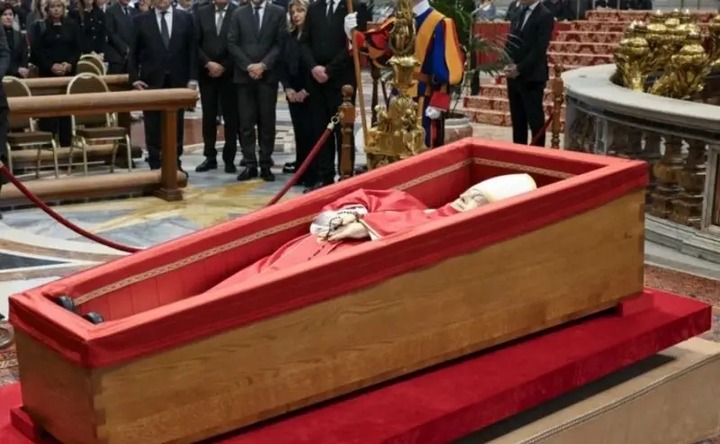Thousands of Catholic faithful gathered in solemn silence at St. Peter’s Basilica in Vatican City to honor the memory of Pope Francis. The basilica, known for its grandeur and history, became a place of deep emotion as mourners filed past the body of the beloved pope. While the sorrow was palpable, many noticed that his final appearance was carefully and symbolically crafted. Each detail surrounding his body seemed to carry a message. It was a quiet, visual reflection of a life spent in service, humility, and unwavering faith.
As people approached the open casket, one of the first things that drew their attention was the deep red robe he was wearing. This color is traditionally used in the Catholic Church during major liturgical events such as Palm Sunday and Good Friday. The red symbolized sacrifice, the blood of Christ, and the profound love that Francis often spoke of throughout his life. It represented not only the suffering of Jesus but also the burdens of those Francis devoted his life to serving, including the poor, the forgotten, and the oppressed. The robe was a clear reminder of how deeply the pope had internalized the idea of sacrificial love, choosing to walk with those on the margins of society.
Covering the red robe was a white pallium, which was marked with small black crosses. This woolen band is worn by popes and senior clergy during Mass. The pallium is made by hand from lamb’s wool, traditionally prepared by Benedictine nuns in Rome. In this context, it was more than just a liturgical garment. It symbolized the weight of leadership and the burden of caring for a global Church. Pope Francis had often spoken about the responsibility of those in power to serve rather than to dominate. The presence of the pallium on his body reflected that belief. It reminded those in attendance of the quiet, steady leadership he had embodied throughout his papacy.
On his head rested a white mitre, a pointed ceremonial headpiece worn by bishops and popes. Unlike the richly decorated tiaras of earlier popes, Francis had chosen a mitre that was simple in design, with only subtle gold lines. This choice echoed the tone he set from the beginning of his leadership. He refused to be seen as a king. He rejected the traditional papal palace and lived in modest quarters. The plain mitre told the same story. It represented humility, a rejection of opulence, and a reminder that holiness does not need to be adorned with wealth or jewels. His decision to wear this style of mitre in death reinforced his lifelong message that simplicity is not weakness but strength.
Another detail that stood out to many observers was the ring on his right hand. Traditionally, popes wear the Ring of the Fisherman, a unique and symbolic piece that signifies their role as the successor of Saint Peter. Upon the death of a pope, this ring is customarily destroyed to mark the end of his authority. However, Pope Francis was not wearing the official papal ring. Instead, he wore a plain silver band that he had worn daily since his time as Archbishop of Buenos Aires. This personal ring was simple and meaningful. It was not a symbol of power but a sign of personal commitment and continuity. Wearing it even in death showed his preference for authenticity over tradition and his dedication to staying true to his roots.
In his hands lay a small silver rosary. The beads were modest in design, lacking any decorative flair. For Catholics around the world, the rosary represents devotion, meditation, and a consistent spiritual rhythm. Placing the rosary in his hands was in line with a long-standing tradition for papal funerals. However, for Pope Francis, it seemed even more appropriate. He was known for his deep prayer life and his constant emphasis on the importance of personal connection with God. The rosary in his hands was not only a symbol of Catholic faith but a reflection of his own private relationship with prayer and spiritual reflection.
The casket itself also spoke volumes. Pope Francis had made a personal request for a simple wooden coffin reinforced with zinc, avoiding any ornate decoration or embellishment. He did not want gold, carvings, or elaborate symbols. This final request was a powerful conclusion to a life marked by humility. It rejected the temptations of legacy-building through wealth or appearance. Instead, he allowed the humility of his life and the love he had shown to others to speak for him.
All these choices were small in appearance but enormous in meaning. They reflected a man who believed that greatness comes not from status but from service. They told the story of a pope who led not by command but by example. They reminded the world that the highest form of leadership is rooted in compassion, honesty, and humility.
As people left the basilica, many carried more than grief. They carried a sense of inspiration. In the quiet, symbolic details of his final appearance, Pope Francis had offered the world one last lesson. It was a lesson not delivered through speeches or documents but through the language of simplicity and sincerity. And it will likely be remembered for generations.
